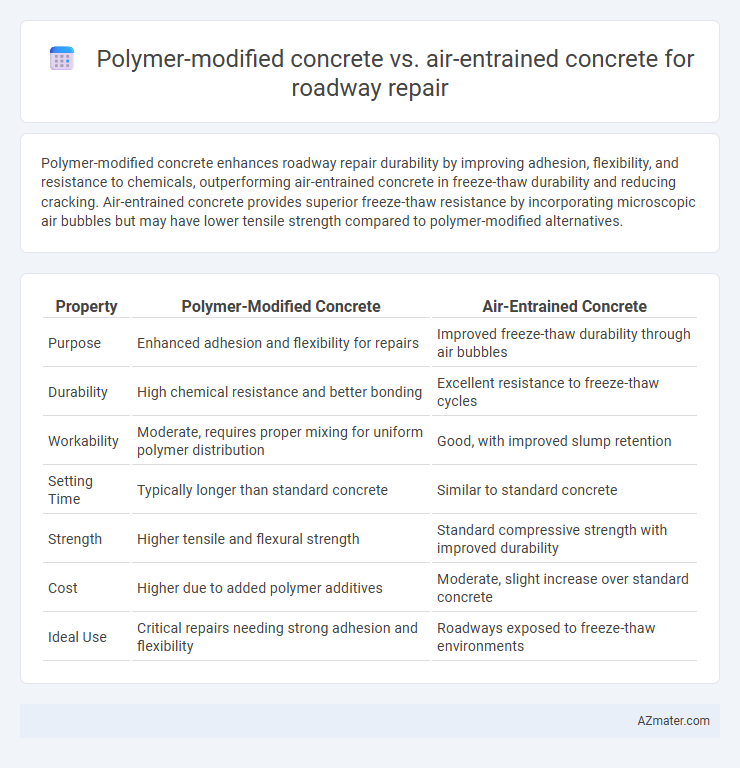Polymer-modified concrete enhances roadway repair durability by improving adhesion, flexibility, and resistance to chemicals, outperforming air-entrained concrete in freeze-thaw durability and reducing cracking. Air-entrained concrete provides superior freeze-thaw resistance by incorporating microscopic air bubbles but may have lower tensile strength compared to polymer-modified alternatives.
Table of Comparison
| Property | Polymer-Modified Concrete | Air-Entrained Concrete |
|---|---|---|
| Purpose | Enhanced adhesion and flexibility for repairs | Improved freeze-thaw durability through air bubbles |
| Durability | High chemical resistance and better bonding | Excellent resistance to freeze-thaw cycles |
| Workability | Moderate, requires proper mixing for uniform polymer distribution | Good, with improved slump retention |
| Setting Time | Typically longer than standard concrete | Similar to standard concrete |
| Strength | Higher tensile and flexural strength | Standard compressive strength with improved durability |
| Cost | Higher due to added polymer additives | Moderate, slight increase over standard concrete |
| Ideal Use | Critical repairs needing strong adhesion and flexibility | Roadways exposed to freeze-thaw environments |
Introduction to Concrete Technologies in Roadway Repair
Polymer-modified concrete enhances roadway repair durability by improving adhesion, flexibility, and resistance to chemicals and freeze-thaw cycles, making it ideal for high-traffic and harsh environment conditions. Air-entrained concrete introduces microscopic air bubbles to increase freeze-thaw resistance and reduce scaling, which is essential for areas exposed to deicing salts and frequent temperature fluctuations. Both technologies play critical roles in modern roadway repair, with polymer-modified concrete offering superior bonding and toughness, while air-entrained concrete provides enhanced durability against environmental stresses.
Overview of Polymer-Modified Concrete
Polymer-modified concrete (PMC) enhances roadway repair through improved adhesion, flexibility, and resistance to abrasion compared to traditional and air-entrained concrete. The incorporation of polymers such as styrene-butadiene rubber (SBR) or acrylic emulsions increases tensile strength and durability, making PMC ideal for high-traffic road surfaces prone to cracking and spalling. Its superior performance in freeze-thaw cycles and chemical exposure ensures longer-lasting repairs with reduced maintenance costs.
Fundamentals of Air-Entrained Concrete
Air-entrained concrete incorporates microscopic air bubbles, enhancing freeze-thaw resistance and durability in roadway repair by reducing internal stress from moisture expansion. This fundamental characteristic improves workability and prevents scaling under harsh weather conditions, making it ideal for cold climates. Polymer-modified concrete, while offering enhanced adhesion and flexural strength, generally does not provide the same level of freeze-thaw protection critical for roadway longevity in environments prone to frequent temperature fluctuations.
Key Differences Between Polymer-Modified and Air-Entrained Concrete
Polymer-modified concrete incorporates synthetic polymers that enhance adhesive properties, flexibility, and resistance to chemical attack, making it ideal for roadway repairs subjected to heavy traffic and harsh environmental conditions. Air-entrained concrete contains microscopic air bubbles that improve freeze-thaw durability and reduce scaling in cold climates, optimizing it for areas prone to seasonal temperature fluctuations. Key differences lie in polymer-modified concrete's superior bonding strength and chemical resistance versus air-entrained concrete's enhanced frost resistance and workability in icy environments.
Performance Under Freeze-Thaw Conditions
Polymer-modified concrete exhibits superior durability under freeze-thaw cycles due to enhanced adhesion and reduced permeability, minimizing microcracking and scaling. Air-entrained concrete provides critical freeze-thaw resistance by incorporating microscopic air bubbles that accommodate ice expansion, significantly improving resistance to surface distress and deterioration. For roadway repair in cold climates, polymer modifications combined with air entrainment often offer optimal performance, balancing strength and freeze-thaw durability.
Durability and Longevity Comparisons
Polymer-modified concrete enhances roadway repair durability by improving bonding strength, reducing permeability, and increasing resistance to chemical attack and freeze-thaw cycles, significantly extending pavement lifespan. Air-entrained concrete offers superior freeze-thaw resistance through microscopic air bubbles but may have lower compressive strength compared to polymer-modified mixes, potentially affecting long-term load-bearing capacity. For longevity, polymer-modified concrete is often preferred in high-traffic or chemically aggressive environments due to its enhanced toughness and reduced cracking susceptibility.
Workability and Placement Considerations
Polymer-modified concrete offers enhanced workability due to improved adhesion and flexibility, facilitating easier placement in complex roadway repairs and reducing the risk of cracking. Air-entrained concrete provides superior freeze-thaw durability by incorporating microscopic air bubbles, though its workability may require careful adjustment of water content and admixtures to ensure proper placement. Selecting between these types depends on environmental conditions and project requirements, balancing ease of handling with long-term performance under traffic stress.
Cost Implications for Roadway Projects
Polymer-modified concrete typically incurs higher initial costs than air-entrained concrete due to the expense of polymer additives that enhance durability and bonding properties. Air-entrained concrete offers a cost-effective solution by improving freeze-thaw resistance and reducing long-term maintenance expenses, particularly in colder climates. Balancing upfront investment with lifecycle savings is crucial for roadway projects aiming to optimize budget efficiency and performance longevity.
Suitability for Various Repair Scenarios
Polymer-modified concrete (PMC) offers superior adhesion, flexibility, and chemical resistance, making it highly suitable for patch repairs and overlays in areas with heavy traffic and exposure to harsh environmental conditions. Air-entrained concrete (AEC) enhances freeze-thaw durability and reduces scaling, ideal for roadway repairs in cold climates where freeze-thaw cycles are frequent. Selecting PMC or AEC depends on specific repair needs, with PMC preferred for structural resilience and bonding, while AEC excels in improving durability against freeze-thaw damage.
Conclusion: Selecting the Right Concrete for Roadway Repair
Polymer-modified concrete offers enhanced durability, chemical resistance, and bonding strength, making it ideal for high-traffic roadways subjected to heavy loads and harsh environmental conditions. Air-entrained concrete provides superior freeze-thaw resistance and improved workability, which is essential in colder climates with frequent temperature fluctuations. Selecting the right concrete depends on specific project requirements such as traffic volume, climate, and expected exposure to de-icing chemicals, with polymer-modified concrete preferred for structural resilience and air-entrained concrete favored for freeze-thaw durability.

Infographic: Polymer-modified concrete vs Air-entrained concrete for Roadway repair
 azmater.com
azmater.com